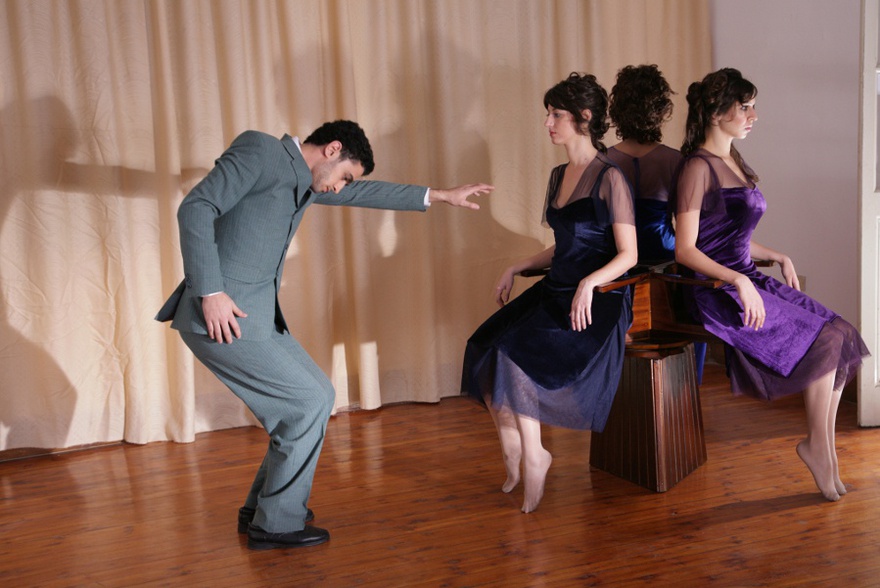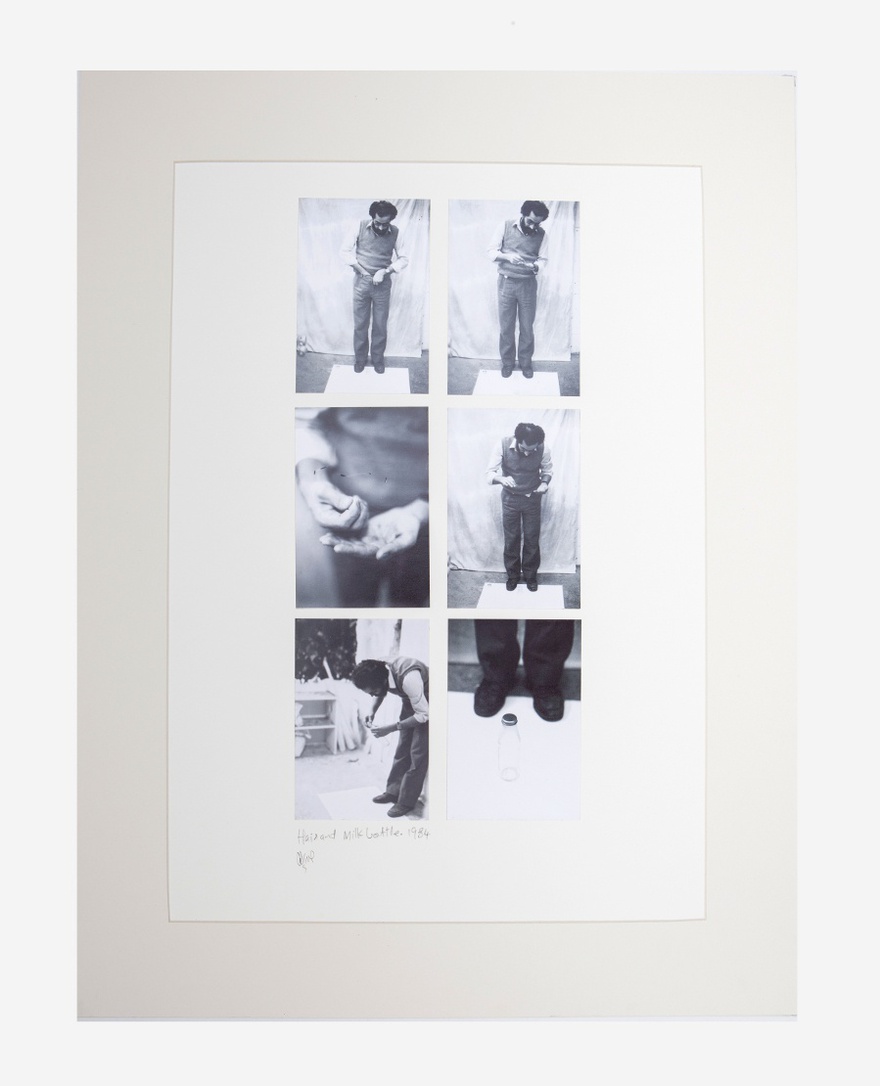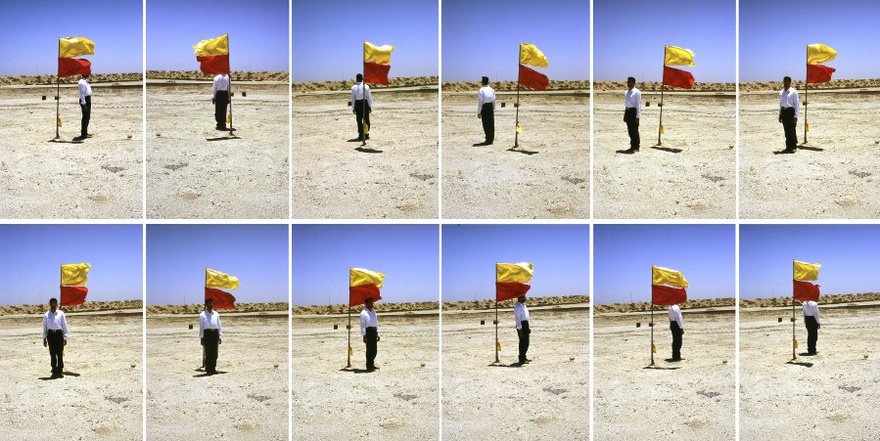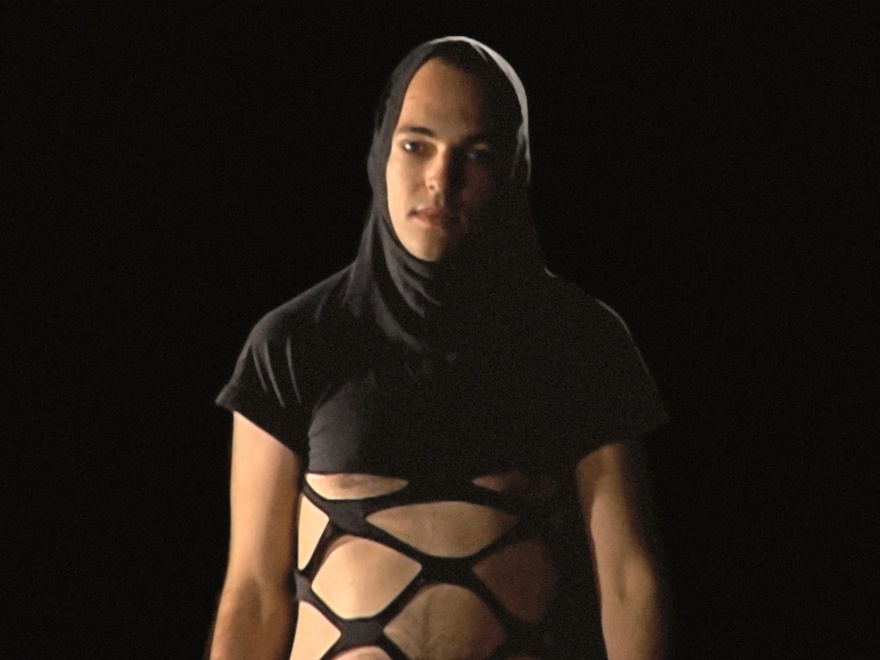Publications
A Prologue to the Past and Present State of Things
Curator's Essay: Aaron Cezar
A Prologue to the Past and Present State of Things is a group exhibition that launches Staging Histories, Delfina Foundation's new research and commissioning platform for performance art. Staging Histories is part of Delfina Foundation's ongoing initiative to develop residency and public programmes for performance art, one of the least supported art forms today, despite the discipline's growing popularity in recent years. Our programme, like this exhibition, explores performance in wide-ranging contexts – from the stage to the white-cube and in the everyday, from daily routines to religious rituals.
Through archival research and new commissions, A Prologue to the Past and Present State of Things aims to trace seminal moments in performance art from, and in relation to, the Arab region. The exhibition attempts to map different lineages of performance art from across this diverse region to other complex histories around the world. It brings together photographs, video documentation, installations and archival materials of key performative works that span the last three decades by 13 international practitioners: Doa Aly, Marwa Arsanios, Coco Fusco, Mona Hatoum, Sharon Hayes, Emily Jacir, Mohammed Kazem, Xiao Lu, Hassan Sharif, Wael Shawky, Sharif Waked, Lin Yilin and the activist-duo The Yes Men with Steve Lambert. While many of the artistic works emerge from the Arab region, they relate to global politics, economics and cultural shifts, and can therefore be understood as a preface, consequence, or echo of major developments during this period. The intention is to open up lines of enquiry for further research that will feed into future iterations of this long-term curatorial project.
But as a starting point for further research, A Prologue to the Past and Present State of Things is not a comprehensive survey. It is a constellation of reference points across shared histories and contemporary global concerns. Works are complemented by reference materials and books by exhibiting artists and other influential practitioners within the Arab region and beyond, such as Walid Raad, Khalil Rabah, RoseLee Goldberg, Francis Alys, Hassan Khan and Wafaa Bilal, amongst others. The ARC.HIVE of Arab performing arts has also contributed copies of rare publications and curated a short programme of videos that opens up channels of research into the history of performance in the Arab region, concentrating on dance and theatre, offering a rich area of study that is key to tracing the various models and traditions that may have come to define performance art in the Arab region today.
Consider here Doa Aly's video A Tress of Hair (2008), a precise choreography with a limited vocabulary of dysfunctional movement. The narrative unfolds slowly and silently with the juxtaposition of text and movement. Various characters populate the work. A woman reclines onto her lovers lap, twisting her body into his. Three female dancers, gently pivot across the screen, carrying with it the textual component of the work. The narrative fuses two stories by the 19th-century French writer Guy de Maupassant to create an 'allegorical cycle of waste: waste of emotions, obsession and of movement.'[1] With narration taken from the original stories of Tress of Hair and Berthe, Aly's video manages to transport the viewer into a fragile universe heavy with aspiration and longing centred on the emotive bodies of the dancers.
In Marwa Arsanios's film OLGA's NOTES, all those restless bodies (2015) the relationship between individual and collective bodies is exposed in a similar kind of choreography. The film focuses on dancers' bodies as a medium with which to discuss socio-political histories of Egypt. Drawing on a 1963 issue of Al-Hilal magazine that describes the establishment of a new dance school in Cairo in terms of modernization, 'the new industry of the body', the use of the dancer as a metaphor for the body politic is invoked.[2] As the artist states, "After years of training, rehearsing, and performing, the dancer's body has become damaged-a metaphor of the violence of state projects, and nation-state building that accompanies a capitalist ideology and a consumerist approach to the human form."[3] Focusing on the bodies of six dancers performing different types of movement, from pole-dancing to the re-enactment of a Yvonne Rainer piece – the film is interspersed with narration and images from the magazine on which the work is based.
OLGA's NOTES, all those restless bodies highlights the porosity of performance between more rigourously defined art forms such as theatre, dance, film, literature and visual arts. Like Aly, Arsanios opens up further areas for consideration within Staging Histories. Namely, how performance art in parts of the world, such as the Arab region, cannot be narrowly defined as in the western world.
Of course, the history of the body in contemporary performance art has been strongly influenced by western art history. From 1981 to 1984, for instance, Hassan Sharif developed his practice at Byam Shaw in London, shortly after Hatoum attended the school (1975–1979).[4] Influenced by the 1960s Fluxus movement, Sharif's early works were in direct response to his student life in London, with his body as a mediator of these experiences, which he enacted both in the UK and at home in the UAE. 'At the time, he took pages of an Arabic to English Dictionary and took photographs of them in assorted urban settings from various distances. This project evolved more recently in Dictionary, 2015: pages of the dictionary clustered together like leaves on cascading cotton rope, which was presented at a recent exhibition at Isabelle van den Eynde alongside these by-now historical images from the eighties.'[5]
'Sharif's work, in this regard, is one in which performance becomes a work of intimate mediation, translation and, ultimately, transmission.'[6] In his practice, small, otherwise insignificant actions involving the body become moments of total intimacy. There is a repetitiveness that Sharif brings into his object work, as in the case of Dictionary, in which pages and pages are stuck together in what might be called a form of automatic making, that he also brought to his early performance. In Hair and Milk Bottle (1984), for instance, which we present in this exhibition, the artist plays a game of throwing his pubic hair into a milk bottle.[7] While a meaningless task, this is an artistic gesture that is deeply personal. It is an example of how performance is able to address both major events and everyday situations on a human level. 'In the case of Dictionary, for instance, we see an entire relation between two different cultures distilled to language and its translation: a history.'[8]
The notion of performance as a form of recording and re-writing history is thus at the core of this exhibition. It focuses on various strategies employed by artists to articulate different perspectives and conditions that would be otherwise not form part of official accounts. Emily Jacir's Crossing Surda (a record of going to and from work) (2002), for instance, documents the difficulties that Palestinians face crossing Israeli checkpoints. In reaction to an incident in which Israeli soldiers detained the artist at gunpoint for filming her feet near a checkpoint, Jacir cut a hole in her bag and covertly filmed her journey to work for eight days. This simple gesture of recording everyday movement is politically significant, especially since the events that took place during the Second Intifada when travel restrictions were heightened in the West Bank.[9]
While Jacir was realizing Crossing Surda (a record of going to and from work), she was also working on the series We Come From Here (2001–03), in which the artist offers her services as a proxy to Palestinians unable to travel to Israel. As an American passport holder, Jacir was able to perform duties on behalf others, such as playing football with Palestinian kids or visiting the graves of loved ones. In emphasizing the mobility of her body against the immobility of those who provide her with the tasks, Jacir's performance challenges the boundaries constituted by national barriers by making them visible through the political status of her own body.
Echoing the simplicity of Jacir's use of performance to document the experience of daily activities on a political level is Mohammed Kazem's Photographs with a Flag (1997). In this photographic series on exhibit in the show, the artist stands around the circumference of a flag that mysteriously appeared one day in the Al Mamzar area of Sharjah. Such flags were often used to demarcate private property and areas of future development in the United Arab Emirates. Using both the flag and his body as a marker of shifting economic and physical terrains, Kazem looks out into the horizon as a witness with what might be described as a mix of nostalgia for the past and optimism for the future.[10] Kazem went on to document the realization of such development projects in other works including Window (2003–2005), a video and photographic series that charts the rise of the Shangri La Hotel as seen from the artist's window. The series also depicts the labour within these massive projects: the migrant workers on the construction site and the employees of the completed hotel as they go about their work routines.
During the same period that Kazem produced Photographs with a Flag, Lin Yilin was producing work that addressed the rapid urbanization in China. Taking the form of public interventions, Yilin's work incorporates common construction materials, particularly concrete bricks and sand, which were easily accessible in the artist's hometown of Guangzhou. In Safely Maneuvering Across the Road (1995), the artist disrupts traffic by moving a wall of concrete brick-by-brick across a busy street, maintaining the shape of the wall through the gridlocked traffic. In Sand Dune (1997), documented in this exhibition with still images, the artist again attempts to build and move a brick wall, but this time across a sand dune on a construction site in Guangzhou. It is an impossible mission as the bricks sink into the sand and the wall fails to maintain its full shape. Whereas Safely Maneuvering Across the Road pointed to the disruption to normal life caused by modernization, Sand Dune alludes to the instability of sustaining such developments.
This kind of global intricacy makes it crucial to connect with performance art practices and movements around the world to generate conversations outside of the strict confines of national identity. Xiao Lu's Dialogue (1989), an installation that includes a red domestic phone on a table in the middle of two phone booths, which were beginning to appear on city streets as symbols of modernity during the late-eighties, similarly looks at the contradictions of China's modernization. Two mannequins dressed as students, were situated in the booths, presumably calling home, where the phone was left dangling off the hook. The visual metaphor suggests a disconnection between the old and the new, the public and the private. When this installation was restaged at the China/Avant-Guard exhibition at the National Art Museum in Beijing in 1989, a complementary performance by Lu, conceived with another artist Tang Song, caused a sensation. Lu fired two shots from a gun directly into her installation; a gesture that she says completed the work as an ultimate act of frustration.
Following the performance, Lu and Song were arrested and the authorities shut China/Avant-Guard down. As a direct implication, the performance art scene was driven underground out of fear, in addition to the extensive censorship enforced on artistic production. Four months after this incident, the Tiananmen Square protests erupted in June 1989. While unrelated, the oppression that provoked Xiao Lu to such theatricality and which led to the shut down of the 1989 exhibition, is reflected in the same oppression that the Tiananmen protests rallied against. What notably link this pair of events – Xiao Lu's performance and the 1989 Tiananmen Crackdown – are the consequences that the protests had on culture.
Political events often become the catalyst for performance and this is most readily witnessed in acts of protest, where collective resistance is enacted through a variety of performative actions. In I March In The Parade of Liberty But As Long As I Love You I'm Not Free (2007–2008), Sharon Hayes uses the form of political protest speech to deliver a love letter that entangles the language of romance and politics, weaving in political slogans with proclamations of love.[11] Through a megaphone on the streets of New York, the artist calls out to her lost lover seeking to rekindle their relationship, which flourished the during Iraq war protests. But as the war continues, the optimism for peace and for the relationship itself dwindles. The work delicately blurs the distinction between the personal and political body as this unknown person – often referred to simply as 'my love' or 'you' – is never clearly defined by the artist.
Within this frame, performance has a subversive potential to undermine authoritative narratives. Coco Fusco's film Operation Atropos (2006) documents a group of women who voluntarily undergo interrogation and Prisoner of War resistance training by ex-United States Army personnel. The simulation mirrors the training of the actual U.S. military to teach civilians how soldiers are taught to cope with such extreme treatment. The work, however, also viscerally exposes the methods of dehumanization used by the military, highlighting the performance of the soldiers in their ability to restage such horrific acts and rationalize their actions. Fusco explored this further through her lecture-performance A Room of One's Own: Women and Power in the New America (2006–2008), which looks at the expanding role of women in the U.S. occupations of Iraq and Afghanistan. By adopting the persona of a female soldier, Fusco explores the shifting nature of power in the War on Terror where, for example, sexual innuendo is a tactic for extracting information from Islamic fundamentalists and women become an ambiguous political force.
Sharif Waked's Chic Point (2005) also playfully disarms dominant power structures through a fashion show of clothing commissioned especially for Israeli checkpoints. Presented as haute couture, the clothes expose torsos and other parts of the body to give agency to Palestinians who undergo humiliating public strip-searches. The absurdity of Waked's intervention is echoed by Lin Yilin's performance A Kind of Machine Called 'Liberation' (2003), which was produced in the same year as the United States invasion of Iraq. Prior to the performance, a circular structure of concrete bricks was constructed around the artist's leg, which remained trapped during the performance. The satirical symbolism of work lies in the collapse of concrete blocks under the relentless yet pathetic weight of a child's bicycle ridden by a fully-grown man. As the brick wall deteriorates, putting both Lin and the cyclist at risk, A Kind of Machine Called 'Liberation' critically reflects on the precarious nature of war and the fragility of life. A performance produced for a live audience, the work was completed by the gaze of spectators who watched helplessly as the action unfolded, themselves taking part as performers of their own inaction.
That the audience is also implicated in the performance is something The Yes Men and Steve Lambert considered when interrogating the mechanics and propaganda of war. Realized in 2009, the work undermined the authority of news media through the creation and distribution of fake copies of The New York Times with the headline: 'IRAQ WAR ENDS'. This major co-production, delivered with 30 writers, 50 advisors, around 1000 volunteer distributors, and the organizations CODEPINK, May First/People Link, Evil Twin, Improv Everywhere and Not An Alternative, speaks to the possibilities of the collective imagination and the potential of performative interventions when it comes to activating a shared imagination. Inside the newspaper, for example, were 14 pages of 'best case scenario' news pieces, each describing the world as it could be eight months in the future. Hypothetical headlines included 'Maximum Wage Law Passes Congress', 'USA Patriot Act repealed', and 'All Public Universities To Be Free'. Each story provided a fictional history and timeline of how these objectives could actually be met through grass-roots pressure using real-world data.
As a tangible object, this imaginary New York Times transported readers to a parallel universe where their hopes and dreams became real news. Later that year, The Yes Men struck again with a 'special edition' of the New York Post with the headline 'We're Screwed'. With reports that New York would face deadly heat waves and extreme flooding, the newspaper was released one day before the United Nations Climate Change Conference. The most alarming thing about this fake edition of the New York Post was that all the news was true: it was fact-checked by experts and largely drawn from an official City report.
This mixture of myth and fact, spectatorship and performative intervention is something Mona Hatoum's performances, from the early years of her practice between 1980 and 1988, relied on heavily. Hatoum's live actions were aimed directly at spectators, often subverting their gaze by shifting her role between that of perpetrator and victim. Concentrating on her relationship with an audience, none of Hatoum's performances were produced for video, and most photographs were created by chance rather than by design.[12] Presented in this exhibition, Variation on Discord and Divisions (1984) draws together different elements of Hatoum's performances Them and Us … and Other Divisions (1984) and The Negotiating Table (1983) with common motifs such as the use of a black mask, red blood-like liquid and innards.[13]
As a series of vignettes, Variation on Discord and Divisions comments on the hostile realities of war and destruction with a perspective that is typical of Hatoum in its refusal to address a particular geographic condition. It instead encompass universal issues, through which Hatoum forces spectators to look beyond her identity as an artist of Palestinian descent in order to consider the network of intricacies that connect conflicts globally. Notably, The Negotiating Table is one of the few examples wherein Hatoum directly refers to specific events in the Arab region, particularly the Lebanese Civil War, which forced her into exile as a student in London. Created in response to the Israeli invasion and massacres in Palestinian refugee camps, Hatoum lays wrapped in plastic and gauze, appearing bruised and bloody with animal entrails. Hatoum is motionless for the three-hour performance, leaving the audience to focus on her breath and the pre-recorded sounds of news reports and speeches by Western leaders.
Hatoum's work underscores one of the themes within the exhibition, which is the symbolic and actual use of the body in performance. The artist's body is as an effective instrument of endurance in the resistance against certain socio-political conditions. In the works discussed so far, we have seen the human body in different states of flux, teetering between action and inaction, the past and future. From China to Palestine to the United States, the politics of the body and the body as the locus for a network of concerns connect all of the works in this exhibition.
In the wider frame of the research project Staging Histories, the material gathered here is a starting point from which artists, writers and researchers can now build further discursive networks that further complicate the histories of performance art around the world. Consider the fact that the body – or rather, the performing body – comes in many forms, from the artist to the composition, and the audience to the documents and artifacts that survive the event. In Wael Shawky's Bent Jbeil (2008), a performance for video that responds to the 2006 Israeli invasion of Lebanon considers the scripture as a form of transmission. The artist physically inserts himself into the narrative, walking through the war torn city reciting verses from the Qur'an relating to the relationship between Jews, Christians and Muslims. The work bears similarities with Shawky's earlier and well-known work The Cave (2004) in which the artist walks through a supermarket reciting verses of the Qur'an that tells the story of men who fall asleep in a cave and are shocked by the world they discover when they awake over 300 years later.[14]
It is this sense of discovery that unites A Prologue to the Past and Present State of Things to two other platforms that also explore the genealogies of performance art in the Arab world: Echoes & Reverberations, a group exhibition at the Hayward Gallery Project space featuring Jumana Emil Abboud, Basma Alsharif, Samah Hijawi, Anas Al-Shaikh, Magdi Mostafa and Joe Namy, and Ibraaz Platform 009, which explores the genealogies of performance art in North Africa and the Middle East. These projects come together with this exhibition in an attempt to draw out the multiple histories from which contemporary performance has emerged.
[1] Quote taken from Doa Aly speaking about her work
[2] Kabra, Fawz, 'Accumulative Processes: Marwa Arsanios in conversation wth Fawz Kabra', Ibraaz, [http://www.ibraaz.org/interviews/164]
[3] Quote taken from Marwa Arsanio's portfolio.
[4] David, Catherine (ed.), Hassan Sharif: Works 1973-2011, (Hatje Cantz Verlag: Ostfildern, 2011), pp. 45-48.
[5] Stephanie Bailey on Hassan Sharif, forthcoming.
[6] Bailey, Op .cit.
[7] David (ed.), Hassan Sharif: Works 1973-2011, p. 48
[8] Bailey, Op. cit.
[9] Masters, HG, 'No Occupation Without Representation: Artists in Palestine', ArtAsiaPacific, July/Aug 2011, [http://www.artasiapacific.com/Magazine/74/NoOccupationWithoutRepresentationArtistsInPalestine]
[10] Kolczynska, Paulina, 'Mohammed Kazem: the Second Generation of Contemporary UAE Artists', Mohammed Kazem, (Damiani: Bologna, 2013), p. 33.
[11] Cohen, Kris, 'Our Broken Genres: Sharon Hayes's Love Addresses', Afterall, n. 38, Spring 2015, [http://www.afterall.org/journal/issue.38/our-broken-genres_sharon-hayes_s-love-addresses]
[12] Heinrich, Christoph (ed.), Mona Hatoum, (Hatje Cantz Verlag: Ostfildern, 2004), p. 109
[13] Heinrich (ed.), Mona Hatoum, p. 109
[14] Shawky, Wael, Horsemen Adore Perfumes and Other Stories, (Sharjah Art Foundation: Sharjah, 2014), p. 44
Further reading:
Fok, Silvia, LIFE & DEATH – Art and The Body in Contemporary China, (Intellect: Bristol and Chicago, 2013)
Xing, Danwen, Xing Danwen: A Personal Diary-China's Avant-Garde in the 1990s, (Scalo: Zurich, 2011)
Bilal, Wafaa, and Kari Lydersen, Shoot an Iraqi: Art, Life and Resistance Under the Gun, (City Lights: San Francisco, 2008)
Rae, Paul, Theatre and Human Rights, (Palgrave Macmillan: London, 2009)
Griffin, Jonathan, 'Hassan Khan: The individual, the communal; theatricality and authenticity', (Frieze Magazine: London, 6th Sept 2006)
Rifky, Sarah, Cairo, Art and the Politics of the Spectacle, (pages 88-93), (Abraaj Capital Art Prize: Cairo, 2010)
Burkhalter, Thomas, Local Music Scenes and Globalization: Transnational Platforms in Beirut, (Routledge: London, 2014)
Wilson-Goldie, Kaelen, 'To The Streets', (Frieze Magazine: London, 3rd May 2011).
Fusco, Coco, Dangerous Moves: Politics and Performance in Cuba, (Tate Publishing: London 2015)
David, Catherine, Hassan Sharif: Works 1973-2010, (Hatje Cantz Verlag: Ostfildern, 2011)
Xiao, Lu, and Archibald McKenzie, Dialogue, (Hong Kong University Press: Hong Kong, 2010)
Illes, Chrissie, Sharon Hayes (Whitney Museum of American Art), (Yale University Press: New York, 2012)
Rubin, Don, The World Encyclopedia of Contemporary Theatre, Volume 4: The Arab World, (Routledge: London, 1999)
Amine, Khalid, and George F. Roberson, Performing Transformations (Collaborative Media Internet: Denver, 2013)
Shafik, Viola, Arab Cinema: History and Cultural identity, (American University Press in Cairo: Cairo, 2007)
Dean, David, Yana Meerzon, and Kathryn Prince, History, Memory, Performance (Studies in International Performance), (Palgrave Macmillan: London 2014)
Mata, Dina and Zahera Harb, Narrating Conflict in the Middle East: Discourse, Image and Communications Practices in Lebanon and Palestine, (I.B. Tauris: London, 2013)
Martin, Carol, Theatre of the Real, (Palgrave Macmillan: London, 2012)














